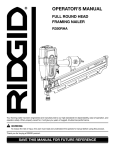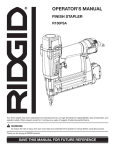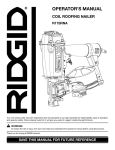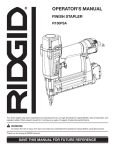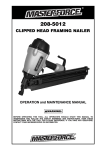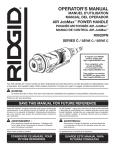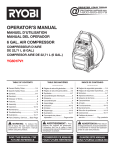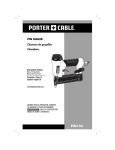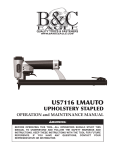Download RIDGID R138HPA Operator`s manual
Transcript
OPERATOR’S MANUAL HEADLESS PINNER R138HPA Your headless pinner has been engineered and manufactured to our high standards for dependability, ease of operation, and operator safety. When properly cared for, it will give you years of rugged, trouble-free performance. WARNING: To reduce the risk of injury, the user must read and understand the operator’s manual before using this product. Thank you for buying a RIDGID® product. SAVE THIS MANUAL FOR FUTURE REFERENCE TABLE OF CONTENTS Introduction......................................................................................................................................................................2 General Safety Rules........................................................................................................................................................3 Specific Safety Rules.................................................................................................................................................... 4-5 Symbols............................................................................................................................................................................6 Glossary of Terms.............................................................................................................................................................7 Features........................................................................................................................................................................ 8-9 Assembly..........................................................................................................................................................................9 Operation.................................................................................................................................................................. 10-16 Maintenance...................................................................................................................................................................17 Accessories....................................................................................................................................................................18 Troubleshooting..............................................................................................................................................................18 Warranty.........................................................................................................................................................................19 Customer Service Information.......................................................................................................................... Back page INTRODUCTION This product has many features for making its use more pleasant and enjoyable. Safety, performance, and dependability have been given top priority in the design of this product making it easy to maintain and operate. GENERAL SAFETY RULES Do not overreach. Keep proper footing and balance at all times. Proper footing and balance enables better control of the tool in unexpected situations. DANGER: READ AND UNDERSTAND TOOL LABELS AND MANUAL. Failure to follow warnings could result in DEATH or SERIOUS INJURY. Use safety equipment. Always wear eye protection. Dust mask, nonskid safety shoes, hard hat, or hearing protection must be used for appropriate conditions. SAVE THESE INSTRUCTIONS WORK AREA Do not use on a ladder or unstable support. Stable footing on a solid surface enables better control of the tool in unexpected situations. Keep your work area clean and well lit. Cluttered benches and dark areas invite accidents. TOOL USE AND CARE Do not force tool. Use the correct tool for your application. The correct tool will do the job better and safer at the rate for which it is designed. Do not operate power tools in explosive atmospheres, such as in the presence of flammable liquids, gases, or dust. Power tools create sparks which may ignite the dust or fumes. Do not use tool if dual actuation trigger system does not actuate properly. Any tool that cannot be controlled with the trigger is dangerous and must be repaired. Keep bystanders, children, and visitors away while operating a power tool. Distractions can cause you to lose control. Store idle tools out of the reach of children and other untrained persons. Tools are dangerous in the hands of untrained users. personal safety Eye protection which conforms to ANSI specifications and provides protection against flying particles both from the FRONT and SIDE should ALWAYS be worn by the operator and others in the work area when loading, operating or servicing this tool. Eye protection is required to guard against flying fasteners and debris, which could cause severe eye injury. Maintain tools with care. Follow maintenance instructions. Properly maintained tools are easier to control. Check for misalignment or binding of moving parts, breakage of parts, and any other condition that may affect the tool’s operation. If damaged, have the tool serviced before using. Many accidents are caused by poorly maintained tools. The employer and/or user must ensure that proper eye protection is worn. We recommend Wide Vision Safety Mask for use over eyeglasses or standard safety glasses that provide protection against flying particles both from the front and side. Always use eye protection which is marked to comply with ANSI Z87.1. Use only fasteners that are recommended for your model. Keep the tool and its handle dry, clean and free from oil and grease. Always use a clean cloth when cleaning. Never use brake fluids, gasoline, petroleum-based products, or any strong solvents to clean your tool. Following this rule will reduce the risk of loss of control and deterioration of the enclosure plastic. Additional safety protection will be required in some environments. For example, the working area may include exposure to noise level which can lead to hearing damage. The employer and user must ensure that any necessary hearing protection is provided and used by the operator and others in the work area. Some environments will require the use of head protection equipment. When required, the employer and user must ensure that head protection conforming to ANSI Z89.1-1997 is used. SERVICE Tool service must be performed only by qualified repair personnel. Service or maintenance performed by unqualified personnel may result in a risk of injury. When servicing a tool, use only identical replacement parts. Follow instructions in the Maintenance section of this manual. Use of unauthorized parts or failure to follow Maintenance instructions may create a risk of injury. Stay alert, watch what you are doing and use common sense when operating a power tool. Do not use tool while tired or under the influence of drugs, alcohol, or medication. A moment of inattention while operating power tools may result in serious personal injury. Dress properly. Do not wear loose clothing or jewelry. Contain long hair. Keep your hair, clothing, and gloves away from moving parts. Loose clothes, jewelry, or long hair can be caught in moving parts. Keep fingers away from the triggers when not driving fasteners to avoid accidental firing. SPECIFIC SAFETY RULES operation Know your pneumatic tool. Read operator’s manual carefully. Learn its applications and limitations, as well as the specific potential hazards related to this tool. Following this rule will reduce the risk of electric shock, fire, or serious injury. Always assume that the tool contains fasteners. Do not carry the tool from place to place holding either trigger. Accidental discharge could result. Always handle the tool with care: Always wear safety glasses with side shields. Everyday glasses have only impact resistant lenses. They are NOT safety glasses. Following this rule will reduce the risk of eye injury. • Respect the tool as a working implement. • Never engage in horseplay. • Never pull the triggers unless nose is directed toward the work. Protect your lungs. Wear a face or dust mask if the operation is dusty. Following this rule will reduce the risk of serious personal injury. • Keep others a safe distance from the tool while tool is in operation as accidental actuation may occur, possibly causing injury. Protect your hearing. Wear hearing protection during extended periods of operation. Following this rule will reduce the risk of serious personal injury. Pneumatic tools are designed for single-hand use. Do not hold the tool by the front of the magazine. Do not put hands, head, or other parts of your body near the bottom of the magazine where the fastener exits the tool, as serious personal injury could result. Make sure the hose is free of obstructions or snags. Entangled or snarled hoses can cause loss of balance or footing and may become damaged. Do not point the tool toward yourself or anyone whether it contains fasteners or not. Do not actuate the tool unless you intend to drive a fastener into the workpiece. Use the tool only for its intended use. Do not discharge fasteners into open air. U se the pneumatic tool only for the purpose for which it was designed. Use only the fasteners recommended for this tool. Use of the wrong fasteners could result in poor fastener feeding, jammed fasteners, and nails leaving the tool at erratic angles. If fasteners are not feeding smoothly and properly, discontinue their use immediately. Jammed and improperly feeding fasteners could result in serious personal injury. Always ensure that the nose of the tool is fully positioned above the workpiece. Positioning the nose only partially above the workpiece could cause the fastener to miss the workpiece completely and result in serious personal injury. Do not drive fasteners near edge of material. The workpiece may split causing the fastener to ricochet, injuring you or a co-worker. Be aware that the fastener may follow the grain of the wood, causing it to protrude unexpectedly from the side of the work material. Never use this tool in a manner that could cause a fastener to be directed toward anything other than the workpiece. Do not use the tool as a hammer. Always carry the tool by the handle. Never carry the tool by the air hose. D o not alter or modify this tool from the original design or function without approval from the manufacturer. Always be aware that misuse and improper handling of this tool can cause injury to yourself and others. Never clamp or tape the secondary trigger in an actuated position. Never leave a tool unattended with the air hose attached. Do not operate this tool if it does not contain a legible warning label. Do not continue to use a tool that leaks air or does not function properly. Keep hands and body parts clear of immediate work area. Hold workpiece with clamps when necessary to keep hands and body out of potential harm. Be sure the workpiece is properly secured before pressing the nailer against the material. The nose may cause the work material to shift unexpectedly. Keep face and body parts away from back of the tool cap when working in restricted areas. Sudden recoil can result in impact to the body, especially when nailing into hard or dense material. SPECIFIC SAFETY RULES During normal use the tool will recoil immediately after driving a fastener. This is a normal function of the tool. Do not attempt to prevent the recoil by holding the nailer against the work. Restriction to the recoil can result in a second fastener being driven from the nailer. Grip the handle firmly, let the tool do the work and do not place second hand on top of tool or near exhaust at any time. Failure to heed this warning can result in serious personal injury. Always disconnect air supply: • Before making adjustments • When servicing the tool • When clearing a jam • When tool is not in use • When moving to a different work area, as accidental actuation may occur, possibly causing injury Do not drive fasteners on top of other fasteners or with the tool at an overly steep angle as this may cause deflection of fasteners which could cause injury. loading tool Do not drive fasteners close to the edge of the workpiece as the wood may split, allowing the fastener to be deflected possibly causing injury. When loading tool: AIR SUPPLY AND CONNECTIONS Never point tool at anyone. Do not use oxygen, combustible gases or bottled gases as a power source for this tool as tool will explode, possibly causing injury or death. Do not pull the dual actuation trigger system, as accidental actuation will occur, possibly causing injury. Do not load the tool with fasteners when any one of the operating controls is activated. Never place a hand or any part of body in fastener discharge area of tool. Save these instructions Do not use with an air compressor which can potentially exceed 200 psi as tool may burst, possibly causing injury. Refer to them frequently and use them to instruct others who may use this tool. If you loan someone this tool, loan them these instructions also. The air fitting on the tool must not hold pressure when air supply is disconnected. If an incorrect fitting is used, the tool can remain charged with air after disconnecting and thus will be able to drive a fastener even after the air line is disconnected, possibly causing injury. SYMBOLS Some of the following symbols may be used on this tool. Please study them and learn their meaning. Proper interpretation of these symbols will allow you to operate the tool better and safer. SYMBOL NAME DESIGNATION/EXPLANATION Read The Operator’s Manual To reduce the risk of injury, user must read and understand operator’s manual before using this product Eye Protection Always wear safety goggles or safety glasses with side shields and, as necessary, a full face shield when operating this product. Eye, Ear and Head Protection Always wear other personal protective equipment such as hearing protection and a hard hat when needed. Keep Hands Away Keep hands and body away from the discharge area of the tool. Safety Alert Precautions that involve your safety. Hot Surface To reduce the risk of injury or damage, avoid contact with any hot surface. The following signal words and meanings are intended to explain the levels of risk associated with this product. SYMBOL SIGNAL MEANING DANGER: Indicates an imminently hazardous situation, which, if not avoided, will result in death or serious injury. WARNING: Indicates a potentially hazardous situation, which, if not avoided, could result in death or serious injury. CAUTION: Indicates a potentially hazardous situation, which, if not avoided, may result in minor or moderate injury CAUTION: (Without Safety Alert Symbol) Indicates a situation that may result in property damage. SERVICE WARNING: Servicing requires extreme care and knowledge and should be performed only by a qualified service technician. For service we suggest you return the product to your nearest AUTHORIZED SERVICE CENTER for repair. When servicing, use only identical replacement parts. To avoid serious personal injury, do not attempt to use this product until you read thoroughly and understand completely the operator’s manual. If you do not understand the warnings and instructions in the operator’s manual, do not use this product. Call RIDGID® customer service for assistance. WARNING: The operation of any power tool can result in foreign objects being thrown into your eyes, which can result in severe eye damage. Before beginning power tool operation, always wear safety goggles or safety glasses with side shields and, when needed, a full face shield. We recommend Wide Vision Safety Mask for use over eyeglasses or standard safety glasses with side shields. Always use eye protection which is marked to comply with ANSI Z87.1. SAVE THESE INSTRUCTIONS GLOSSARY OF TERMS Activate (operating controls) Jam To move an operating control so that it is in a position that allows the tool to be actuated or that satisfies one requirement for the tool to be actuated. An obstruction in the feed or drive areas of the tool. Maximum air pressure The maximum allowable pressure of the compressed air, as specified by the manufacturer, for operating a tool. Actuate (tool) To cause movement of the tool component(s) intended to drive a fastener. Nose The part of the tool that is placed against the workpiece for placement of the fastener. Air inlet port In an air tool, the opening to which the compressed air supply is connected, usually by means of a threaded fitting. Operating control A control that separately, or as part of an actuation system, can cause the actuation of a tool. Dual actuation trigger system An actuation system in which there are two triggers that must be pulled in a specific sequence in order to drive a fastener. Trigger A tool operating control activated by a tool operator’s fingers. Fastener Workpiece A staple, pin, brad, nail, or other fastening device which is designed and manufactured for use in the tools within the scope of this standard. The intended object into which a fastener is to be driven by a tool. FEATURES PRODUCT SPECIFICATIONS Operating Pressure............................................. 70-100 psi Magazine Capacity.........................................130 Fasteners Fastener size range....................................5/8 in. - 1-3/8 in. Fastener gauge type....................... 23 gauge headless pins Air Consumption............................ 0.95 ft3/cycle at 100 psi Air Inlet............................................................... 1/4 in. NPT Weighted sound impulse power level.....................86.9 dBA Emission sound pressure level...............................73.9 dBA Vibration................................................................ 0.87 m/s2 Weight.........................................................................2.1 lb. QUICK-CONNECT SWIVEL CONNECTOR secondARY trigger PRIMARY trigger BELT Hook RELOAD INDICATOR NO-MAR PAD MAGAZINE HEX KEY STORAGE NOSE NO-MAR PAD STORAGE ON-BOARD STORAGE Fig. 1 FEATURES KNOW YOUR Headless pinner internal piston catch See Figure 1. The safe use of this product requires an understanding of the information on the tool and in this operator’s manual as well as a knowledge of the project you are attempting. Before use of this product, familiarize yourself with all operating features and safety rules. The internal piston catch delivers consistent driving power. MUFFLER The muffler reduces noise during operation. NO-MAR PAD The no-mar pad prevents marring and denting when using the tool on softer woods. BELT hook The pinner can be hung from a tool belt when disconnected and not in use. The belt hook can be set on either the left or right side, depending on operator preference. ON-BOARD STORAGE The headless pinner has convenient on-board storage for a hex key and no-mar pad. DUAL ACTUATION TRIGGER SYSTEM quick-connect swivel connector The headless pinner has a dual actuation trigger system. The secondary trigger must be pulled before a fastener can be driven by pulling the primary trigger. The quick-connect swivel connector helps prevent hose tangles. in-handle air filter reload indicator The self-cleaning in-handle air filter helps keep debris out to extend the life of the tool. The reload indicator lets the operator see if the magazine is ready to reload with fasteners. ASSEMBLY UNPACKING This product has been shipped completely assembled. WARNING: Carefully remove the tool and any accessories from the box. Make sure that all items listed in the packing list are included. If any parts are damaged or missing, do not operate this tool until the parts are replaced. Failure to heed this warning could result in possible serious personal injury. Inspect the tool carefully to make sure no breakage or damage occurred during shipping. Do not discard the packing material until you have carefully inspected and satisfactorily operated the tool. WARNING: Do not attempt to modify this tool or create accessories not recommended for use with this tool. Any such alteration or modification is misuse and could result in a hazardous condition leading to possible serious personal injury. If any parts are damaged or missing, please call 1-866-539-1710 for assistance. PACKING LIST Headless Pinner Oil Hex Keys Sample Fasteners Eye Protection Fastener Guide Operator’s Manual OPERATION DANGER: WARNING: Do not use oxygen, combustible gases, or bottled gases as a power source for this tool. The tool will explode and cause death or serious injury. Always wear eye protection. Eye protection does not fit all operators in the same way. Make sure the eye protection chosen has side shields or provides protection from flying debris both from the front and sides. WARNING: APPLICATIONS Do not allow familiarity with tools to make you careless. Remember that a careless fraction of a second is sufficient to inflict severe injury. You may use this tool for the purposes listed below: Light wood assembly Finish and trim work Decorative moldings WARNING: Picture frame assemblies Always wear safety goggles or safety glasses with side shields when operating tools. Failure to do so could result in objects being thrown into your eyes resulting in possible serious injury. Joint and dowel pinning Window beading crafts WARNING: Disconnect the tool from the air supply before leaving the work area, moving the tool to another location, or handing the tool to another person. Failure to do so could result in serious personal injury. 10 OPERATION PREPARING the tool for use QUICK CONNECT SWIVEL CONNECTOR See Figure 2. Under normal use conditions, the tool should be lubricated before connecting the tool to an air supply. Add air tool oil into the quick connect swivel connector once daily with minimal use, or twice a day with heavy use. Only a few drops of oil at a time is necessary. Too much oil will only collect inside the tool and will be noticeable in the exhaust cycle. Before connecting the tool, check the air compressor gauge to be sure it is functioning within the proper range of 70-100 psi. changing the belt hook position See Figure 3. The belt hook can be positioned on either the left or right side of the tool, depending on operator preference. To change the belt hook position: Fig. 2 DEFLECTOR PLATE Using a 3 mm hex key, remove the screws that attach the belt hook to the tool. belt hook Switch the belt hook to the opposite side. Make sure the deflector plate remains attached to the tool before securing the belt hook into position. SCREW(S) Reinsert the screws in the holes and tighten the screws securely. no-MAR PAD See Figure 4. The no-mar pad attached to the nose of the tool helps prevent marring and denting when working with softer woods. Fig. 3 WARNING: Disconnect the tool from the air supply before removing or replacing the no-mar pad. Failure to do so could result in serious personal injury. The no-mar pad for the headless pinner can be removed by pulling it away from the nose of the tool. To replace the pad, fit it into place over the nose. ON-BOARD STORAGE NO-MAR PAD See Figure 4. HEX KEY STORAGE On-board storage for the no-mar pad is located on the body of the tool. Hex key storage is located in the same area. NO-MAR PAD STORAGE Fig. 4 11 OPERATION WARNING: Disconnect the tool from the air supply before leaving the work area, moving the tool to another location, or handing the tool to another person. Failure to do so could result in serious personal injury. QUICK CONNECT SWIVEL CONNECTOR CONNECTING THE TOOL TO AN AIR SUPPLY See Figure 5. FEMALE QUICK CONNECTOR WARNING: The tool’s driving mechanism may cycle when the tool is first connected to the air supply. Always connect the tool to the air supply before loading fasteners to prevent injury from unintended cycling. Always make sure the tool’s magazine is empty at the beginning of each work session, before connecting to an air supply. Fig. 5 WARNING: DANGER: Always use an air fitting that discharges all the compressed air in the tool at the time the fitting or female quick connector is disconnected. Using an air fitting that does not discharge the compressed air could cause unintended operation and serious personal injury. Do not use oxygen, combustible gases or bottled gases as a power source for this tool. The tool will explode and cause death or serious injury. This tool is designed to operate on clean, dry compressed air at regulated pressures between 70 and 100 psi . The correct air pressure is the lowest pressure that will do the job. NOTE: Air pressure that is higher than 100 psi may damage the tool. WARNING: Do not climb rigging or scaffolding while carrying a tool that is connected to an air hose. Doing so could result in serious personal injury. The tool and air hose must have an air fitting that allows all pressure to be discharged from the tool when the female quick connector is disconnected. Connect the tool to the air supply with a 1/4 in. female quick connector. 12 OPERATION WARNING: PRIMARY TRIGGER The headless pinner is capable of driving a fastener without making contact with a workpiece. Always point the tool away from yourself or others and always direct the fastener toward the work surface before pulling the trigger. Failure to do so could result in possible serious personal injury. SECONDARY TRIGGER LATCH LOADING THE TOOL WITH Fasteners See Figures 6 - 7. WARNING: The tool’s driving mechanism may cycle when the tool is first connected to the air supply. Always connect the tool to the air supply before loading fasteners to prevent injury from unintended cycling. Always make sure the tool’s magazine is empty at the beginning of each work session, before connecting to an air supply. TO OPEN Fig. 6 WARNING: Keep the tool pointed away from yourself and others when loading fasteners. Failure to do so could result in possible serious personal injury. WARNING: Use only the fasteners recommended for use with this tool (refer to the Fastener Guide). The use of any other fasteners can result in tool malfunction, leading to serious injuries. Fasteners WARNING: When loading fasteners, do not pull the dual actuation trigger system, as accidental actuation will occur, possibly causing injury. GROOVE Fig. 7 removing FASTENERs from the tool Connect the tool to the air supply. Depress the latch and slide the magazine open. Make sure the secondary trigger has locked out the primary trigger. Insert the fasteners, pointed end down, into the groove in the nail track as shown. Fasteners should sit securely in the nail track. NOTE: Your fasteners may be marked with an arrow, indicating the pointed end. Slide the magazine to close. Make sure the latch is secure. Disconnect the tool from the air supply. WARNING: Disconnect the tool from the air supply before removing fasteners. Failure to do so could result in serious personal injury. To remove a strip of fasteners from the tool, depress the latch located at the rear of the magazine and slide the magazine open. Remove the fasteners. 13 OPERATION DRIVING A FASTENER See Figures 8 - 9. WARNING: Never wedge or hold back the secondary trigger during operation of the tool. Doing so could result in possible serious injury. WARNING: Do not pull the dual actuation trigger system unless the nose of the pinner is pressed against the work surface. Accidental actuation will occur, possibly causing injury. The tool is shipped from the factory with a dual trigger actuation system. The secondary trigger must be pulled in order to pull the primary trigger. Each time the primary trigger is pulled, the tool will drive a fastener. Each time a fastener is driven, the exhaust will direct a blast of air from the rear of the tool. Keep your face away from this area. Remove fasteners or make sure that the magazine is empty of fasteners. PRIMARY TRIGGER secondaRY TRIGGER Fig. 8 Connect the tool to an air supply. Load the tool with fasteners. Grip the tool firmly to maintain control. Press the nose of the tool against the work surface. Pull the secondary trigger. Pull the primary trigger to drive a fastener. Allow the tool to recoil away from the work surface as the fastener is driven. WARNING: During normal use the tool will recoil immediately after driving a fastener. This is a normal function of the tool. Do not attempt to prevent the recoil by holding the nailer against the work. Restriction to the recoil can result in a second fastener being driven from the nailer. Grip the handle firmly, let the tool do the work, and do not place second hand on top of tool or near exhaust at any time. Failure to heed this warning can result in serious personal injury. nose 14 Fig. 9 OPERATION setting the AIR pressure The amount of air pressure required will depend on the size of the fastener and the workpiece material. Begin testing the depth of drive by driving a test fastener into the same type of workpiece material used for the actual job. FRONT PLATE BOLTS Drive a test fastener with the air pressure set at 80-85 psi. Raise or lower the air pressure to find the lowest setting that will perform the job with consistent results. It may be possible to achieve the desired depth with air pressure adjustments alone. If finer adjustments are needed, use the drive depth adjustment on the tool. drivE depth ADJUSTMENT See Figure 10. The pinner is factory-set to its maximum depth.The driving depth of the fastener may be adjusted to a more shallow depth. It is advisable to test the depth on a scrap workpiece to determine the required depth for the application. To determine depth of drive, first adjust the air pressure and drive a test fastener. NOTE: Fasteners of more than 1-3/16 in. in length may not drive flush in dense woods. To fine-adjust to a shallower depth of drive: Disconnect the tool from the air supply. Fig. 10 Using a 3 mm hex key, loosen the two bolts on the front plate. Do not remove the bolts. Slide the front plate toward the nose slightly. Adjustment is accomplished with very little movement of the front plate. The plate should be positioned so that it cannot slip over the bolts. Tighten the bolts securely with the hex key. Reconnect the tool to the air supply. Drive a test fastener after each adjustment until the desired depth is set. 15 OPERATION WARNING: Disconnect the tool from the air supply before removing fasteners or clearing a jammed fastener. Failure to do so could result in serious personal injury. SCREWDRIVER CLEARING A JAMMED FASTENER BOLTS See Figure 11. If a fastener becomes jammed in the tool, disconnect the air hose and keep the tool pointed away from you while clearing the jam. Disconnect the tool from the air supply. FRONT PLATE Remove fasteners from the magazine. Using a 3 mm hex wrench, remove the two bolts and front plate. Remove the jammed fastener. Make sure the nail track is free of bent fasteners or fragments. If the driver blade prevents removal of bent fasteners or fragments, use a small flat-blade screwdriver to gently tap the driver blade backwards past the jammed fastener. Remove the jammed fastener and make sure the nail track is free of bent fasteners or fragments. Fig. 11 Reinstall the front plate and bolts, making sure they are secure. Reconnect the tool to the air supply. Reload the tool with fasteners. 16 MAINTENANCE cold weather operation WARNING: For cold weather operation, near and below freezing, the moisture in the air line may freeze and prevent tool operation. We recommend the use of air tool lubricant or permanent antifreeze (ethylene glycol) as a cold weather lubricant. When servicing use only identical RIDGID replacement parts. Use of any other parts may create a hazard or cause product damage. CAUTION: WARNING: Do not store tools in a cold weather environment to prevent frost or ice formation on the tools’ operating valves and mechanisms that could cause tool failure. Always wear safety goggles or safety glasses with side shields during power tool operation or when blowing dust. If operation is dusty, also wear a dust mask. NOTE: Some commercial air line drying liquids are harmful to “O” rings and seals. Do not use these low temperature air dryers without checking compatibility. WARNING: Disconnect the tool from the air supply before performing maintenance. Failure to do so could result in serious personal injury. AIR SUPPLY PRESSURE AND VOLUME Air volume is as important as air pressure. The air volume supplied to the tool may be inadequate because of undersize fittings and hoses, or from the effects of dirt and water in the system. Restricted air flow will prevent the tool from receiving an adequate volume of air, even though the pressure reading is high. The results will be a slow operation, misfeeds or reduced driving power. Before evaluating tool problems for these symptoms, trace the air supply from the tool to the supply source for restrictive connectors, low points containing water and anything else that would prevent full volume flow of air to the tool. GENERAL MAINTENANCE Avoid using solvents when cleaning plastic parts. Most plastics are susceptible to damage from various types of commercial solvents and may be damaged by their use. Use clean cloths to remove dirt, dust, oil, grease, etc. WARNING: Do not at any time let brake fluids, gasoline, petroleum-based products, penetrating oils, etc., come in contact with plastic parts. Chemicals can damage, weaken or destroy plastic which may result in serious personal injury. REQUIRED DAILY CHECKLIST Disconnect the air supply from the tool and remove all fasteners. Check all screws, nuts, bolts, and pins on the tool. If any of these are loose, they must be tightened with the appropriate size wrench. LUBRICATION Pull the secondary and primary triggers. Cycle them several times to ensure that they function smoothly without binding. Frequent, but not excessive, lubrication is required for best performance. Oil for pneumatic fastening tools added through the air line connection will lubricate the internal parts. Do not use detergent oil or additives as these lubricants will cause accelerated wear to the seals and bumpers in the tool, resulting in poor tool performance and frequent tool maintenance. While the tool is not loaded, connect the appropriate air supply (at 70 psi) to the tool. No air should leak from the tool. Place the nose of the tool on the workpiece. Attempt to pull the primary trigger without first pulling the secondary trigger. The primary trigger should not disengage the secondary trigger, and the unit should not cycle. Pull the primary trigger in this manner several times. Place the nose of the tool on the workpiece. Pull the secondary trigger and hold. Then pull the primary trigger several times. The tool must operate properly. If the tool successfully meets all the requirements in this checklist, it is ready for use. 17 ACCESSORIES To order parts and maintenance kits, call 1-866-539-1710. Driver Maintenance Kit.....................................................................................................................................079028001064 Overhaul Kit......................................................................................................................................................079028001063 Oil and Wrench Kit...........................................................................................................................................079028001062 WARNING: Current attachments and accessories available for use with this tool are listed above. Do not use any attachments or accessories not recommended by the manufacturer of this tool. The use of attachments or accessories not recommended can result in serious personal injury. TROUBLESHOOTING PROBLEM POSSIBLE CAUSE SOLUTION Air leak near the top of the tool or in the trigger area Loose cap Tighten cap Worn or damaged O-rings or seals Install Overhaul Kit Air leak near the bottom of the tool Worn or damaged O-rings or bumper Install Overhaul Kit Tool does nothing or operates sluggishly Inadequate air supply Verify adequate air supply Inadequate lubrication Lubricate the tool Worn or damaged O-rings or bumper Install Overhaul Kit Incorrect fasteners Verify that fasteners are the correct size Damaged fasteners Replace fasteners Loose magazine or nose bolts Tighten bolts Dirty magazine Clean magazine Worn or damaged driver Install Driver Maintenance Kit Fasteners are not placed toward the bottom of the magazine Install fastener tips at the bottom of the magazine Fasteners are inserted backward Make sure the point of the fasteners and directional arrow point down toward the bottom of the magazine Tool jams frequently 18 WARRANTY RIDGID® PNEUMATIC TOOL 3 YEAR LIMITED SERVICE WARRANTY Proof of purchase must be presented when requesting WHAT IS NOT COVERED warranty service. This warranty applies only to the original purchaser at retail and may not be transferred. This warranty only covers defects arising under normal usage and does not cover any malfunction, failure or defect resulting from misuse, abuse, neglect, alteration, modification or repair by other than an authorized service center for RIDGID® branded pneumatic tools. Consumable accessories provided with the tool such as, but not limited to, fasteners, oil, and safety glasses are not covered. This product is manufactured by One World Technologies, Inc. The trademark is licensed from RIDGID, Inc. All warranty communications should be directed to One World Technologies, Inc., attn: RIDGID Pneumatic Tool Technical Service at (toll free) 1-866-539-1710. 90-DAY SATISFACTION GUARANTEE POLICY During the first 90 days after the date of purchase, if you are dissatisfied with the performance of this RIDGID® Pneumatic Tool for any reason you may return the tool to the dealer from which it was purchased for a full refund or exchange. To receive a replacement tool you must present proof of purchase and return all original equipment packaged with the original product. The replacement tool will be covered by the limited warranty for the balance of the 3-YEAR service warranty period. RIDGID, INC. AND One World Technologies, Inc. make no warranties, representations or promises as to the quality or performance of its pneumatic tools other than those specifically stated in this warranty. ADDITIONAL LIMITATIONS To the extent permitted by applicable law, all implied warranties, including warranties of MERCHANTABILITY or FITNESS FOR A PARTICULAR PURPOSE, are disclaimed. Any implied warranties, including warranties of merchantability or fitness for a particular purpose, that cannot be disclaimed under state law are limited to three years from the date of purchase. One World Technologies, Inc. and RIDGID, Inc. are not responsible for direct, indirect, incidental or consequential damages. Some states do not allow limitations on how long an implied warranty lasts and/or do not allow the exclusion or limitation of incidental or consequential damages, so the above limitations may not apply to you. This warranty gives you specific legal rights, and you may also have other rights which vary from state to state. WHAT IS COVERED UNDER THE 3 YEAR LIMITED SERVICE WARRANTY This warranty on RIDGID® Pneumatic Tools covers all defects in workmanship or materials and normal wear items for three years following the purchase date of the tool. Warranties for other RIDGID® products may vary. HOW TO OBTAIN SERVICE To obtain service for this RIDGID® tool you must return it; freight prepaid, or take it in to an authorized service center for RIDGID® branded pneumatic tools. You may obtain the location of the authorized service center nearest you by calling (toll free) 1-866-539-1710 or by logging on to the RIDGID® website at www.ridgid.com. When requesting warranty service, you must present the original dated sales receipt. The authorized service center will repair any faulty workmanship, and either repair or replace any part covered under the warranty, at our option, at no charge to you. One World Technologies, Inc. P.O. Box 35, Hwy. 8 Pickens, SC 29671 19 OPERATOR’S MANUAL Headless pinner R138HPA Customer Service Information: For parts or service, contact your nearest RIDGID authorized service center. Be sure to provide all relevant information when you call or visit. For the location of the authorized service center nearest you, please call 1-866-539-1710 or visit us online at www.ridgid.com. The model number of this tool is found on a plate attached to the magazine cover of the tool. Please record the serial number in the space provided below. When ordering repair parts, always give the following information: Model No. Serial No. 987000-183 9-19-07 (REV:00) R138HPA 20




















